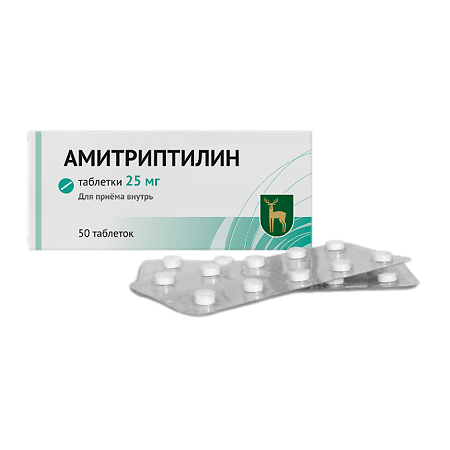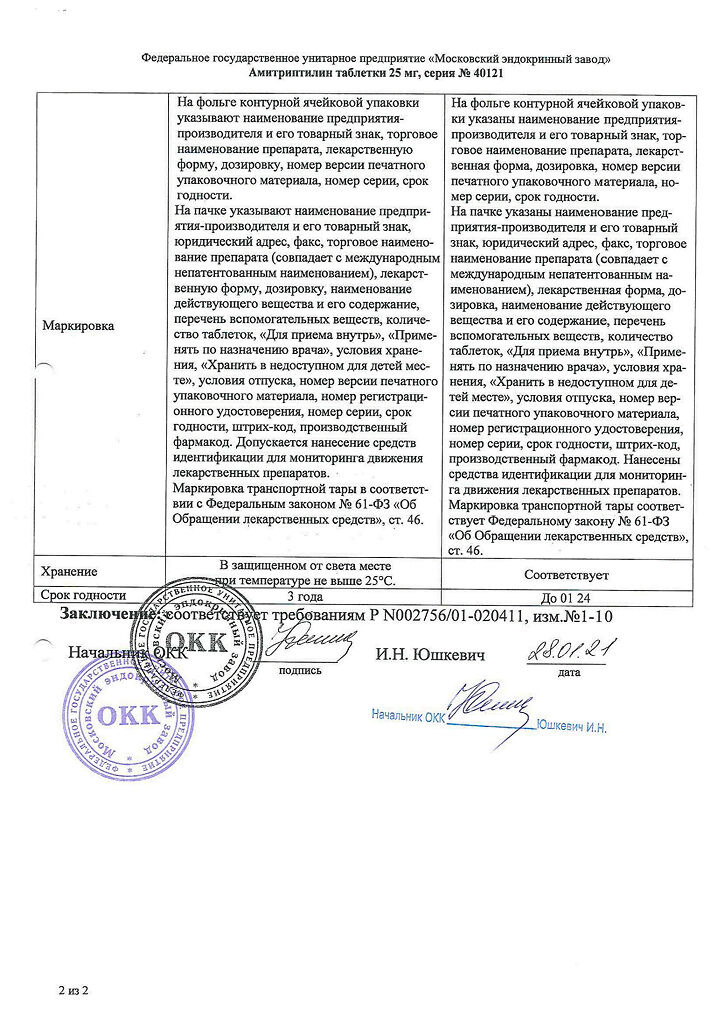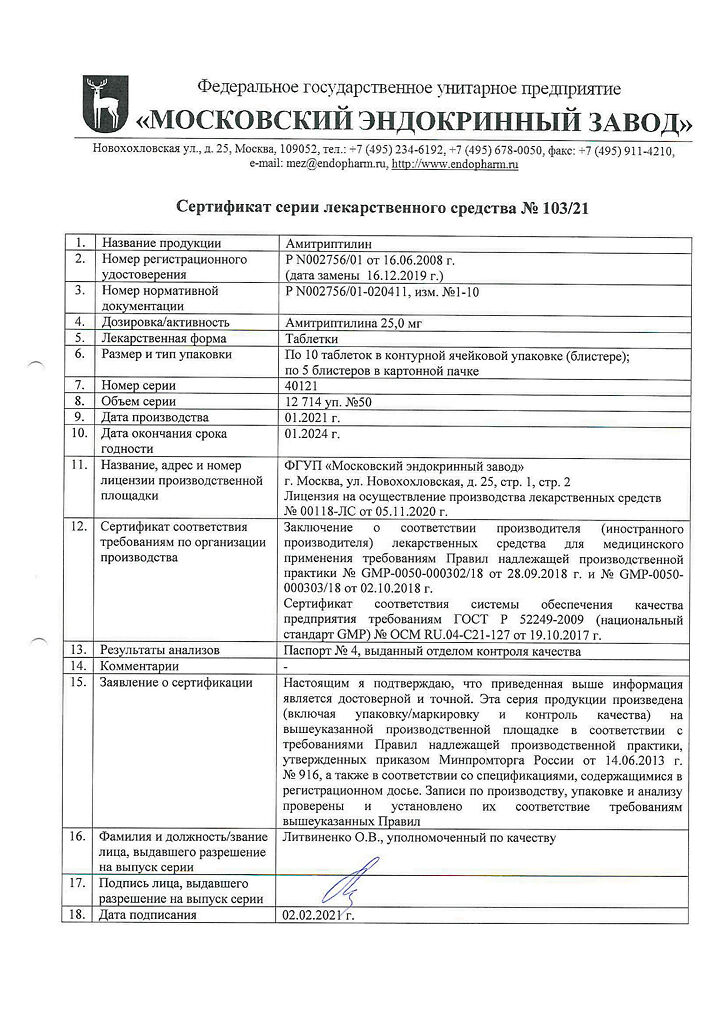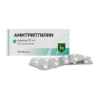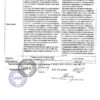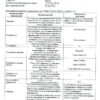No products in the cart.
Amitriptyline, tablets 25 mg 50 pcs
€0.74 €0.61
Out of stock
(E-mail when Stock is available)
Description
Pharmacodynamics
Amitriptyline is an antidepressant (tricyclic antidepressant). It also has some analgesic (of central genesis), antiserotonin action, helps eliminate nocturnal urinary incontinence and reduces appetite.
It has strong peripheral and central anticholinergic action due to high affinity to m-cholinoreceptors; strong sedative effect associated with affinity to H1-histamine receptors and alpha-adrenoblocking action. It has the properties of an antiarrhythmic drug (drug of class IA); like quinidine, in therapeutic doses it slows ventricular conduction (in overdose it may cause severe intraventricular blockade).
The mechanism of antidepressant action is associated with an increase in the concentration of noradrenaline and/or serotonin in the central nervous system (reduction of their reverse absorption). Accumulation of these neurotransmitters occurs as a result of inhibition of their reuptake by membranes of presynaptic neurons. With long-term use it reduces the functional activity of beta-adrenergic and serotonin receptors of the brain, normalizes adrenergic and serotonergic transmission, restores the balance of these systems that are disturbed in depressive states. In anxiety-depressive states it reduces anxiety, agitation and depressive manifestations.
The mechanism of anti-ulcer action is due to the ability to have sedative and m-cholinoblocking effects.
The efficacy in nocturnal urinary incontinence appears to be due to anticholinergic activity resulting in increased bladder distension capacity, direct beta-adrenergic stimulation, alpha-adrenergic agonist activity accompanied by increased sphincter tone, and central serotonin takeover blockade.
It has a central analgesic effect, which is thought to be due to changes in CNS monoamine concentrations, particularly serotonin, and to effects on endogenous opioid systems.
The mechanism of action in bulimia nervosa is unclear (it may be similar to that in depression). The drug has been shown to have a distinct bulimia effect in patients both without and with depression, and a decrease in bulimia may be seen without concomitant relief of depression itself.
In general anesthesia, it reduces blood pressure (BP) and body temperature. It does not inhibit monoamine oxidase (MAO).
The antidepressant effect develops within 2-3 weeks after the start of use.
Pharmacokinetics
Absorption is high. Bioavailability of amitriptyline is 30-60%, its active metabolite nortriptyline – 46-70%. Time to reach maximum concentration (Tmax) after oral administration 2.0-7.7 hours. The volume of distribution is 5-10 l/kg. Effective therapeutic blood concentrations for amitriptyline are 50-250 ng/ml, for nortriptyline 50-150 ng/ml. Maximum plasma concentrations (Cmax) are 0.04-0.16 µg/ml. Passes (including nortriptyline) through histohematic barriers, including the blood-brain barrier, placental barrier, penetrates into breast milk. Binding with plasma proteins is 96%.
It is metabolized in the liver with participation of CYP2C19, CYP2D6 isoenzymes, has “first pass” effect (by demethylation, hydroxylation) with the formation of active metabolites – nortriptyline, 10-hydroxy-amitriptyline, and inactive metabolites. The blood plasma elimination half-life (T1/2) is 10-26 hours for amitriptyline and 18-44 hours for nortriptyline. Excreted by the kidneys (mainly as metabolites) – 80% in 2 weeks, partially in the bile.
Indications
Indications
Depression (especially with anxiety, agitation and sleep disorders, including in childhood, endogenous, involutional, reactive, neurotic, drug-induced, with organic brain damage).
As part of complex therapy, it is used for mixed emotional disorders, psychosis in schizophrenia, alcohol withdrawal, behavioral disorders (activity and attention), nocturnal enuresis in children (except for patients with bladder hypotension), bulimia nervosa, chronic pain syndrome (chronic pain in cancer patients, migraine, rheumatic diseases, atypical pain in the face, postherpetic neuralgia, posttraumatic neuropathy, diabetic or other peripheral neuropathy), headaches, migraines (prevention), gastric and duodenal ulcers.
Pharmacological effect
Pharmacological effect
Pharmacodynamics
Amitriptyline is an antidepressant (tricyclic antidepressant). It also has some analgesic (of central origin), antiserotonin effect, helps eliminate bedwetting and reduces appetite.
It has a strong peripheral and central anticholinergic effect due to its high affinity for m-cholinergic receptors; strong sedative effect associated with affinity for H1-histamine receptors and alpha-adrenergic blocking effect. It has the properties of a class IA antiarrhythmic drug (drug), like quinidine in therapeutic doses, it slows down ventricular conduction (in overdose it can cause severe intraventricular blockade).
The mechanism of antidepressant action is associated with an increase in the concentration of norepinephrine and/or serotonin in the central nervous system (CNS) (decreasing their reabsorption). The accumulation of these neurotransmitters occurs as a result of inhibition of their reuptake by the membranes of presynaptic neurons. With long-term use, it reduces the functional activity of beta-adrenergic and serotonin receptors in the brain, normalizes adrenergic and serotonergic transmission, and restores the balance of these systems, disturbed during depressive states. In anxiety-depressive conditions, it reduces anxiety, agitation and depressive symptoms.
The mechanism of antiulcer action is due to the ability to have a sedative and m-anticholinergic effect.
Effectiveness for bedwetting appears to be due to anticholinergic activity leading to increased bladder distensibility, direct beta-adrenergic stimulation, alpha-adrenergic agonist activity leading to increased sphincter tone, and central blockade of serotonin uptake.
It has a central analgesic effect, which is believed to be associated with changes in the concentration of monoamines in the central nervous system, especially serotonin, and an effect on endogenous opioid systems.
The mechanism of action in bulimia nervosa is unclear (may be similar to that in depression). A clear effect of the drug on bulimia has been shown in patients both without depression and in its presence, while a decrease in bulimia can be observed without a concomitant weakening of depression itself.
During general anesthesia, it reduces blood pressure (BP) and body temperature. Does not inhibit monoamine oxidase (MAO).
The antidepressant effect develops within 2-3 weeks after the start of use.
Pharmacokinetics
Absorption is high. The bioavailability of amitriptyline is 30-60%, its active metabolite nortriptyline is 46-70%. Time to reach maximum concentration (Tmax) after oral administration is 2.0-7.7 hours. Volume of distribution is 5-10 l/kg. Effective therapeutic blood concentrations for amitriptyline are 50-250 ng/ml, for nortriptyline 50-150 ng/ml. The maximum concentration in blood plasma (Cmax) is 0.04-0.16 mcg/ml. Passes (including nortriptyline) through histohematic barriers, including the blood-brain barrier, placental barrier, and penetrates into breast milk. Communication with plasma proteins – 96%.
Metabolized in the liver with the participation of isoenzymes CYP2C19, CYP2D6, has a “first pass” effect (by demethylation, hydroxylation) with the formation of active metabolites – nortriptyline, 10-hydroxy-amitriptyline, and inactive metabolites. The plasma half-life (T1/2) is 10-26 hours for amitriptyline and 18-44 hours for nortriptyline. Excreted by the kidneys (mainly in the form of metabolites) – 80% in 2 weeks, partly with bile.
Special instructions
Special instructions
Before starting treatment, blood pressure monitoring is necessary (in patients with low or labile blood pressure, it may decrease even more); during the treatment period – control of peripheral blood (in some cases, agranulocytosis may develop, and therefore it is recommended to monitor the blood picture, especially with an increase in body temperature, development of flu-like symptoms and sore throat), during long-term therapy – control of the functions of the cardiovascular system and liver. In the elderly and patients with cardiovascular diseases, monitoring of heart rate (HR), blood pressure, and ECG is indicated. Clinically insignificant changes may appear on the ECG (smoothing of the T wave, depression of the S-T segment, widening of the QRS complex).
Caution is required when suddenly moving to a vertical position from a lying or sitting position.
During the treatment period, the use of ethanol should be avoided.
Prescribed no earlier than 14 days after discontinuation of MAO inhibitors, starting with small doses.
If you suddenly stop taking it after long-term treatment, withdrawal syndrome may develop.
Amitriptyline in doses above 150 mg/day reduces the threshold of convulsive activity (the risk of epileptic seizures in predisposed patients should be taken into account, as well as in the presence of other factors predisposing to the occurrence of convulsive syndrome, for example, brain damage of any etiology, simultaneous use of antipsychotic drugs (neuroleptics), during the period of refusal of ethanol or withdrawal of drugs with anticonvulsant properties, for example benzodiazepines).
Severe depression is characterized by a risk of suicidal actions, which can persist until significant remission is achieved. In this regard, at the beginning of treatment, a combination with drugs from the group of benzodiazepines or neuroleptic drugs and constant medical supervision (entrusting the storage and dispensing of drugs to trusted persons) may be indicated.
In children, adolescents and young adults (under 24 years of age) with depression and other mental disorders, antidepressants, compared with placebo, increase the risk of suicidal thoughts and behavior. Therefore, when prescribing amitriptyline or any other antidepressants in this category of patients, the risk of suicide should be weighed against the benefits of their use. In short-term studies, the risk of suicide did not increase in people over 24 years of age, but it decreased slightly in people over 65 years of age. During treatment with antidepressants, all patients should be monitored for early detection of suicidal tendencies.
In patients with cyclic affective disorders during the depressive phase, manic or hypomanic states may develop during therapy (reducing the dose or discontinuing the drug and prescribing an antipsychotic drug are necessary). After relief of these conditions, if indicated, treatment in low doses can be resumed.
Due to possible cardiotoxic effects, caution is required when treating patients with thyrotoxicosis or patients receiving thyroid hormone preparations.
In combination with electroconvulsive therapy, it is prescribed only under the condition of careful medical supervision.
In predisposed patients and elderly patients, it can provoke the development of drug-induced psychoses, mainly at night (after discontinuation of the drug, they disappear within a few days).
May cause paralytic ileus, primarily in patients with chronic constipation, the elderly, or those forced to bed rest.
Before performing general or local anesthesia, the anesthesiologist should be warned that the patient is taking amitriptyline.
Due to the anticholinergic effect, there may be a decrease in tear production and a relative increase in the amount of mucus in the tear fluid, which can lead to damage to the corneal epithelium in patients using contact lenses.
With long-term use, an increase in the incidence of dental caries is observed. The need for riboflavin may be increased.
Animal reproduction studies have shown adverse effects on the fetus, and there are no adequate and well-controlled studies in pregnant women. In pregnant women, the drug should be used only if the expected benefit to the mother outweighs the potential risk to the fetus.
Passes into breast milk and may cause drowsiness in nursing infants.
To avoid the development of withdrawal syndrome in newborns (manifested by shortness of breath, drowsiness, intestinal colic, increased nervous excitability, increased or decreased blood pressure, tremors or spastic phenomena), amitriptyline is gradually discontinued at least 7 weeks before the expected birth.
Children are more sensitive to acute overdose, which should be considered dangerous and potentially fatal to them.
During the treatment period, care must be taken when driving vehicles and engaging in other potentially hazardous activities that require increased concentration and speed of psychomotor reactions.
Active ingredient
Active ingredient
Amitriptyline
Composition
Composition
1 tablet contains:
active ingredient:
amitriptyline hydrochloride – 28.30 mg, which corresponds to 25 mg of amitriptyline
Pregnancy
Pregnancy
Use during lactation is contraindicated.
Contraindications
Contraindications
Hypersensitivity,
use together with MAO inhibitors and 2 weeks before starting treatment,
myocardial infarction (acute and subacute periods),
acute alcohol intoxication,
acute intoxication with hypnotic, analgesic and psychoactive drugs,
angle-closure glaucoma,
severe disturbances of AV and intraventricular conduction (bundle branch block, AV block II degree),
lactation period,
children under 6 years of age.
Due to the content of lactose monohydrate (milk sugar), the drug should not be taken by patients with rare hereditary diseases such as galactose intolerance, lactase deficiency or glucose-galactose malabsorption.
With caution
Amitriptyline should be used with caution in persons with alcoholism, bronchial asthma, schizophrenia (possible activation of psychosis), bipolar disorder, epilepsy, suppression of bone marrow hematopoiesis, diseases of the cardiovascular system (CVS) (angina pectoris, arrhythmia, heart block, chronic heart failure, myocardial infarction, arterial hypertension), intraocular hypertension, stroke, decreased motor function of the gastrointestinal tract (GIT) (risk of paralytic ileus), liver and/or renal failure, thyrotoxicosis, prostatic hyperplasia, urinary retention, hypotension of the bladder, during pregnancy (especially the first trimester), in old age.
Side Effects
Side Effects
Associated with the anticholinergic effect of the drug: blurred vision, accommodation paralysis, mydriasis, increased intraocular pressure (only in persons with a local anatomical predisposition – a narrow anterior chamber angle), tachycardia, dry mouth, confusion (delirium or hallucinations), constipation, paralytic ileus, difficulty urinating.
From the central nervous system: drowsiness, fainting, fatigue, irritability, anxiety, disorientation, hallucinations (especially in elderly patients and patients with Parkinson’s disease), anxiety, psychomotor agitation, mania, hypomania, memory impairment, decreased ability to concentrate, insomnia, nightmares, asthenia; headache; dysarthria, tremor of small muscles, especially the arms, hands, head and tongue, peripheral neuropathy (paresthesia), myasthenia gravis, myoclonus; ataxia, extrapyramidal syndrome, increased frequency and intensification of epileptic seizures; changes in the electroencephalogram (EEG).
From the cardiovascular system: tachycardia, palpitations, dizziness, orthostatic hypotension, nonspecific changes in the electrocardiogram (ECG) (S-T interval or T wave) in patients without heart disease; arrhythmia, blood pressure lability (decrease or increase in blood pressure), intraventricular conduction disturbances (widening of the QRS complex, changes in the P-Q interval, bundle branch block).
From the gastrointestinal tract: nausea, heartburn, gastralgia, hepatitis (including impaired liver function and cholestatic jaundice), vomiting, increased appetite and body weight or decreased appetite and body weight, stomatitis, changes in taste, diarrhea, darkening of the tongue.
From the endocrine system: increase in size (swelling) of the testicles, gynecomastia; increase in the size of the mammary glands, galactorrhea; decreased or increased libido, decreased potency, hypo- or hyperglycemia, hyponatremia (decreased vasopressin production), syndrome of inappropriate secretion of antidiuretic hormone (ADH).
Allergic reactions: skin rash, itching, photosensitivity, angioedema, urticaria.
Other: hair loss, tinnitus, edema, hyperpyrexia, swollen lymph nodes, urinary retention, pollakiuria.
With long-term treatment, especially in high doses, if it is abruptly stopped, withdrawal syndrome may develop: nausea, vomiting, diarrhea, headache, malaise, sleep disturbances, unusual dreams, unusual agitation; with gradual withdrawal after long-term treatment – irritability, motor restlessness, sleep disturbances, unusual dreams.
The connection with taking the drug has not been established: lupus-like syndrome (migratory arthritis, the appearance of antinuclear antibodies and positive rheumatoid factor), impaired liver function, ageusia.
Interaction
Interaction
With the combined use of ethanol and drugs that depress the central nervous system (including other antidepressants, barbiturates, benzadiazepines and general anesthetics), a significant increase in the inhibitory effect on the central nervous system, respiratory depression and hypotensive effect is possible.
Increases sensitivity to drinks containing ethanol.
Increases the anticholinergic effect of drugs with anticholinergic activity (for example, phenothiazine derivatives, antiparkinsonian drugs, amantadine, atropine, biperiden, antihistamine drugs), which increases the risk of side effects (from the central nervous system, vision, intestines and bladder). When used together with anticholinergic blockers, phenothiazine derivatives and benzodiazepines, there is a mutual enhancement of the sedative and central anticholinergic effects and an increased risk of epileptic seizures (lowering the threshold of convulsive activity); Phenothiazine derivatives may also increase the risk of neuroleptic malignant syndrome.
When used together with anticonvulsants, it is possible to enhance the inhibitory effect on the central nervous system, reduce the threshold of convulsive activity (when used in high doses) and reduce the effectiveness of the latter.
When used together with antihistamines, clonidine – increased inhibitory effect on the central nervous system; with atropine – increases the risk of paralytic intestinal obstruction; with drugs that cause extrapyramidal reactions – an increase in the severity and frequency of extrapyramidal effects.
With the simultaneous use of amitriptyline and indirect anticoagulants (coumarin or indadione derivatives), the anticoagulant activity of the latter may increase.
Amitriptyline may enhance depression caused by glucocorticosteroids (GCS).
Drugs for the treatment of thyrotoxicosis increase the risk of developing agranulocytosis.
Reduces the effectiveness of phenytoin and alpha-blockers.
Inhibitors of microsomal oxidation (cimetidine) prolong T1/2, increase the risk of developing toxic effects of amitriptyline (a dose reduction of 20-30% may be required); inducers of microsomal liver enzymes (barbiturates, carbamazepine, phenytoin, nicotine and oral contraceptives) reduce plasma concentrations and reduce the effectiveness of amitriptyline.
Combined use with disulfiram and other acetaldehydrogenase inhibitors provokes delirium.
Fluoxetine and fluvoxamine increase plasma concentrations of amitriptyline (a 50% reduction in amitriptyline dose may be required).
Estrogen-containing oral contraceptives and estrogens may increase the bioavailability of amitriptyline.
With the simultaneous use of amitriptyline with clonidine, guanethidine, betanidine, reserpine and methyldopa – a decrease in the hypotensive effect of the latter; with cocaine – the risk of developing cardiac arrhythmias.
Antiarrhythmic drugs (such as quinidine) increase the risk of developing rhythm disturbances (possibly slowing down the metabolism of amitriptyline).
Pimozide and probucol may increase cardiac arrhythmias, which is manifested by prolongation of the QT interval on the ECG.
It enhances the effect of epinephrine, norepinephrine, isoprenaline, ephedrine and phenylephrine on the cardiovascular system (including when these drugs are part of local anesthetics) and increases the risk of developing heart rhythm disturbances, tachycardia, and severe arterial hypertension.
When co-administered with alpha-adrenergic agonists for intranasal administration or for use in ophthalmology (with significant systemic absorption), the vasoconstrictor effect of the latter may be enhanced.
When taken together with thyroid hormones, there is a mutual enhancement of the therapeutic effect and toxic effects (including cardiac arrhythmias and a stimulating effect on the central nervous system).
M-anticholinergic drugs and antipsychotic drugs (neuroleptics) increase the risk of developing hyperpyrexia (especially in hot weather).
When co-administered with other hematotoxic drugs, increased hematotoxicity is possible.
Incompatible with MAO inhibitors (increased frequency of periods of hyperpyrexia, severe convulsions, hypertensive crises and patient death are possible).
Overdose
Overdose
Symptoms: From the central nervous system: drowsiness, stupor, coma, ataxia, hallucinations, anxiety, psychomotor agitation, decreased ability to concentrate, disorientation, confusion, dysarthria, hyperreflexia, muscle rigidity, choreoathetosis, epileptic syndrome.
From the cardiovascular system: decreased blood pressure, tachycardia, arrhythmia, impaired intracardiac conduction, ECG changes (especially QRS) characteristic of intoxication with tricyclic antidepressants, shock, heart failure; in very rare cases – cardiac arrest.
Other: respiratory depression, shortness of breath, cyanosis, vomiting, hyperthermia, mydriasis, increased sweating, oliguria or anuria.
Symptoms develop 4 hours after an overdose, reach a maximum after 24 hours and last 4-6 days. If an overdose is suspected, especially in children, the patient should be hospitalized.
Treatment: for oral administration: gastric lavage, intake of activated charcoal; symptomatic and supportive therapy; for severe anticholinergic effects (lowering blood pressure, arrhythmia, coma, myoclonic epileptic seizures) – administration of cholinesterase inhibitors (the use of physostigmine is not recommended due to the increased risk of seizures); maintaining blood pressure and water-electrolyte balance. Monitoring of cardiovascular functions (including ECG) for 5 days (relapse may occur after 48 hours or later), anticonvulsant therapy, artificial pulmonary ventilation (ALV) and other resuscitation measures are indicated. Hemodialysis and forced diuresis are ineffective.
Storage conditions
Storage conditions
In a dry place, protected from light, at a temperature not exceeding 25 ° C.
Shelf life
Shelf life
2 years.
Manufacturer
Manufacturer
Moscow Endocrine Plant, Russia
Additional information
| Shelf life | 2 years. |
|---|---|
| Conditions of storage | In a dry, light-protected place at a temperature not exceeding 25 ° C. |
| Manufacturer | Moscow Endocrine Plant, Russia |
| Medication form | pills |
| Brand | Moscow Endocrine Plant |
Related products
Buy Amitriptyline, tablets 25 mg 50 pcs with delivery to USA, UK, Europe and over 120 other countries.

